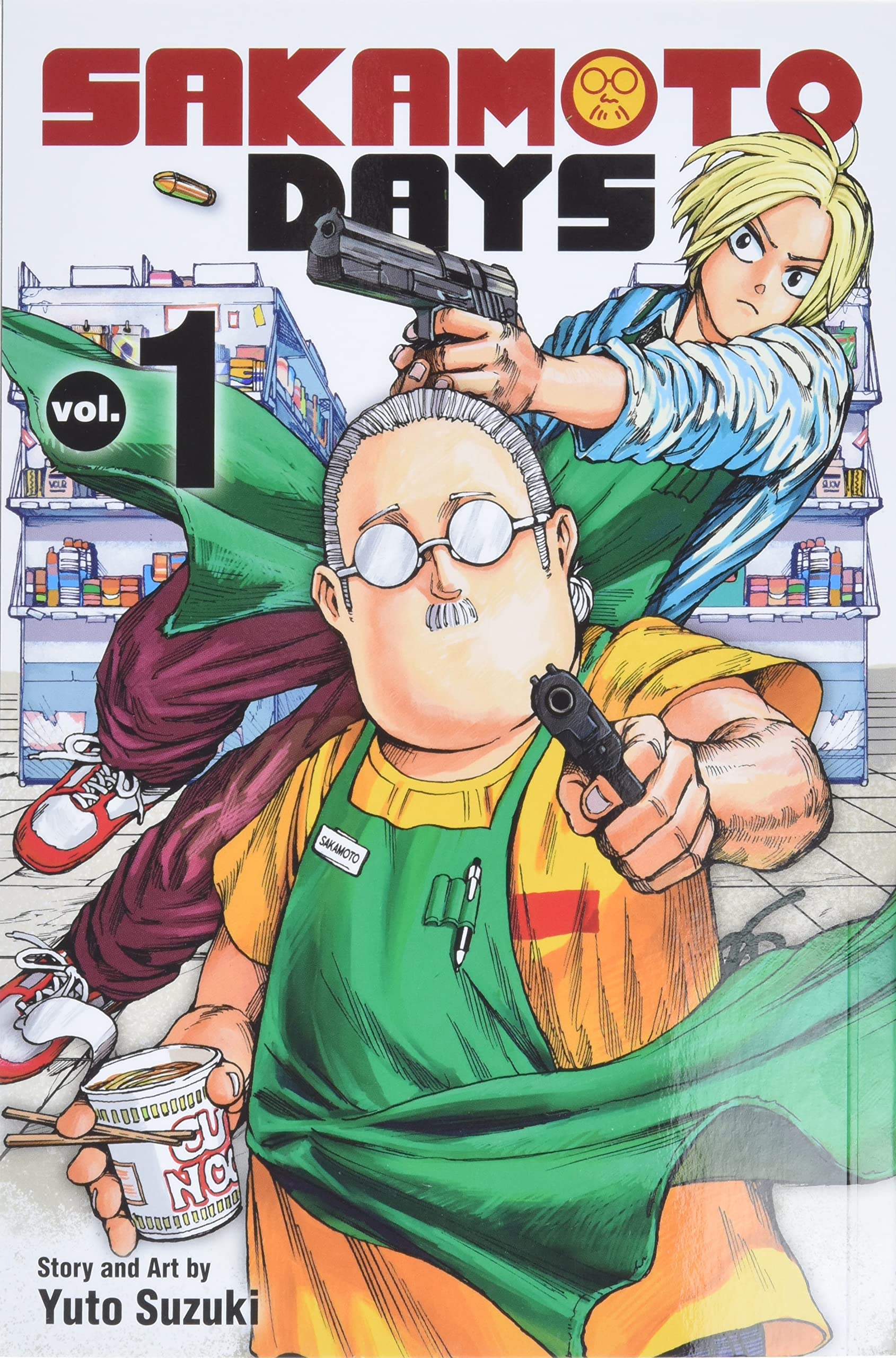Sayonara, Zetsubou-Sensei: The Power of Negative Thinking may not be as relentlessly intertextual as Ulysses, but this Japanese import is nearly as rich in puns, social commentary, pop-culture parody, and allusions to TV shows, novels, movies, and manga. I can’t imagine adapting such a culturally specific text for Western audiences, yet the folks at Del Rey have made a game effort to do just that. Given the scope and complexity of the task, I think translator Joyce Aurino has produced an eminently readable script that captures the darkness and absurdity of Koji Kumeta’s original. I just wish it were, y’know, funnier.
The premise seems ripe with comic potential. High school teacher and profound pessimist Nozomu Itoshiki lands the gig from hell: an all-female class of stalkers, hikokimori, obsessive text-messagers, bossy perfectionists, panty-flashers, and perky optimists. Try as he might to escape his obligations, his students foil his repeated suicide attempts, compounding his sense of despair and driving him to more extreme, ridiculous measures.
Through a series of interconnected vignettes, we begin to grasp the true extent of Itoshiki’s negativity as well as the sheer nuttiness of his students. In “Zetsubou-Sensei Returns,” for example, Itoshiki instructs his students to complete a “Post Graduation Career Hope Survey” by listing the three dreams they’re least likely to realize, e.g. playing baseball for Yomiuri Giants, recording a best-selling pop album. His sour-spirited effort quickly backfires, however, when the school’s guidance counselor reads the responses and praises Itoshiki for encouraging his students to dream big. In “Before Me, There’s No One; Behind Me, There’s You,” Matoi Tsunetsuki, a.k.a. “super-love-obsessed stalker girl,” develops an unhealthy attachment to Itoshiki. Matoi pursues her teacher with steely determination, adopting his trademark yukata, building a shrine to him, and following him everywhere. The chapter ends with a brilliant stroke, as one of Matoi’s former love interests begins tailing her to find out who’s replaced him, only to discover a chain of stalkers trailing in Matoi and Itoshiki’s wake.
Unfortunately, many of the stories require too much editorial intervention to elicit real laughs, as Kumeta’s panels abound in the kind of small but important details that resist easy translation: brand name parodies, puns on famous literary works, misspelled words, and so forth. The story titles, too, require explanation; “Behind Me, There’s No One,” for example, is a riff on a poem by Kotaro Takamura, while “Beyond the Tunnel Was Whiteness” appropriates a line from Yasanuri Kuwabata’s Snow Country. Absent this rich network of cultural references, Kometa’s comedy loses some of its fizz, playing more like a mild satire of shojo manga conventions than a scathing commentary on contemporary Japan.
If the text sometimes disappoints, the artwork does not. Kumeta uses a stark palette with large patches of pure black and plenty of white space. His highly stylized character designs have a pleasing, geometric quality about them, as do the patterns in their clothing. Though his faces are the essence of simplicity— just a few lines and two dark coals for eyes—Kumeta animates them with skill, registering the full gamut of emotions from anger to joy. His students are virtually interchangeable, save for their accessories and hairstyles: a black eye and a sling for the class masochist, blonde hair and strawberry-print underpants for the class exhibitionist. Again, Kumeta’s economy of form works beautifully, underscoring the extent to which Itoshiki views all of the girls in the same light: as nuisances.
I wish I liked Sayonara, Zetsubou-Sensei better, as I think Kumeta is a terrific artist with a fertile imagination. But it’s awfully hard to laugh when 70% of the jokes require footnotes. (If you disagree, try this exercise: watch an episode of Seinfeld, The Chapelle Show, or South Park with someone who’s new to the United States. Then try explaining why the jokes work. You’ll quickly realize the degree to which the creators rely on your knowledge of literature, politics, movies, and pop music for laughs.) I’m also a little uncomfortable with the way Kumeta depicts the female students, as he skates a thin line between poking fun at stock manga characters and portraying teenage girls as desperate, manipulative, boy-crazed hysterics. I wouldn’t go as far as to label the text misogynist—that term seems much too strong—but I would feel more at ease with the material if Kumeta’s cast was comprised of troublesome girls and boys—equal opportunity neurosis, if you will.
That said, I’m not ready to declare Zetsubou-Sensei a dud; I’m just not sure how invested I am in a series that requires its own set of cultural Cliff Notes to decode.
This review originally appeared at The Manga Curmudgeon on March 4, 2009.




Aaron says:
Sayonara, Zetsubou-Sensei is one those series that released in English that ends up having a very passionate cult following like Gintama. Or simply having a very Japanese or niche sense of humor comparable to something like the Melancholy of Suzumiya Haruhi-chan. Admittedly I read five volumes Zetsubou-Sensei as that was what was available at my local Barnes and Noble.
It gets funnier as the series goes on mostly because the cast gets larger so it has more personalities to play off of each other. Admittedly the obscure to an English Langauge audience Japanese cultural references are a bit of a learning curve. Although some of the popularity of the series may be due to the fact that Studio Shaft worked on the Anime adaptation of the series.
And of course one more generalized problems with reviewing comedy is if you criticize it someone can just retort that they found it funny and move on completely short-circuiting any attempt at critcical dialogue or be accused of “explaining the joke is to kill the joke”.
Kaere/Kaede Kimura works for the most part as a mockery of the “ugly American” and certain archaic aspects of Japanese culture. While the panty shots, for the most part, a kind self-aware recognition of their existence by other characters as she is basically ridiculed in latter volumes for being nothing more than the fanservice character.
Katherine Dacey says:
Thanks for your two cents, Aaron! Since it’s been almost a decade since I last looked at Zetsubou-Sensei, I’ll have to go back and re-read it. Maybe I’d find it a more rewarding experience now since I have a slightly greater level of Japanese cultural fluency than when I reviewed volume one.
Aaron says:
I did not realize the review was from 2009 originally until I scrolled to the end. I blame having been reviewing YuYu Hakusho for about half a week almost every day. as I just thought someone else was doing a review of an older series.
You can get the first fourteen volumes of Sayonara Zetsubou-Sensei on Kindle but that’s it Kodansha apparently quit putting it out. Which considering the turnover on translators for the series I can’t blame them. As thirty volumes of a dense caustic Japanese Comedy Manga series didn’t feel like a commitment they were willing to make.
Also, the review was written before Del Ray ultimately ended up exiting the manga business in December 2010.